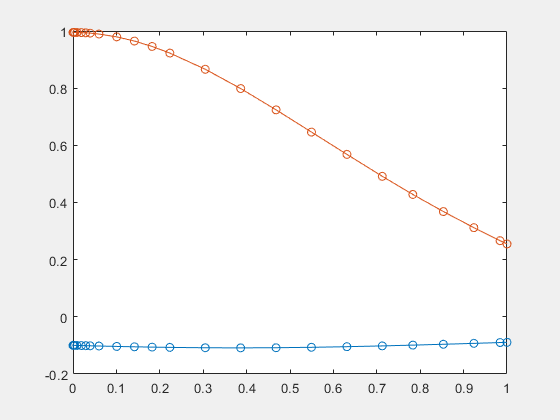daeFunction
Convert system of differential algebraic equations to MATLAB function handle suitable for ode15i
Description
f = daeFunction(___,Name=Value)Name=Value
arguments.
Examples
Create the system of differential algebraic equations. Here, the symbolic functions x1(t) and x2(t) represent the state variables of the system. The system also contains constant symbolic parameters a, b, and the parameter function r(t). These parameters do not represent state variables. Specify the equations and state variables as two symbolic vectors: equations as a vector of symbolic equations, and variables as a vector of symbolic function calls.
syms x1(t) x2(t) a b r(t) eqs = [diff(x1(t),t) == a*x1(t) + b*x2(t)^2,... x1(t)^2 + x2(t)^2 == r(t)^2]; vars = [x1(t),x2(t)];
Use daeFunction to generate a MATLAB® function handle f depending on the variables x1(t), x2(t) and on the parameters a, b, r(t).
f = daeFunction(eqs,vars,a,b,r(t))
f = function_handle with value:
@(t,in2,in3,param1,param2,param3)[in3(1,:)-param1.*in2(1,:)-param2.*in2(2,:).^2;-param3.^2+in2(1,:).^2+in2(2,:).^2]
Specify the parameter values, and create the reduced function handle F as follows.
aVal = -0.6; bVal = -0.1; rFunc = @(t) cos(t)/(1 + t^2); F = @(t,Y,YP) f(t,Y,YP,aVal,bVal,rFunc(t));
Specify consistent initial conditions for the DAE system.
t0 = 0; y0 = [-rFunc(t0)*sin(0.1); rFunc(t0)*cos(0.1)]; yp0 = [aVal*y0(1) + bVal*y0(2)^2; 1.234];
Now, use ode15i to solve the system of equations.
ode15i(F,[t0,1],y0,yp0)

Write the generated function handle to a file by specifying
the File option. When writing to a file,
daeFunction optimizes the code using intermediate
variables named t0, t1, .… Include
comments in the file using the Comments option.
Write the generated function handle to the file
myfile.
syms x1(t) x2(t) a b r(t)
eqs = [diff(x1(t),t) == a*x1(t) + b*x2(t)^2,...
x1(t)^2 + x2(t)^2 == r(t)^2];
vars = [x1(t),x2(t)];
daeFunction(eqs,vars,a,b,r(t),File="myfile")function eqs = myfile(t,in2,in3,param1,param2,param3) %MYFILE % EQS = MYFILE(T,IN2,IN3,PARAM1,PARAM2,PARAM3) % This function was generated by the Symbolic Math Toolbox version 7.3. % 01-Jan-2017 00:00:00 YP1 = in3(1,:); x1 = in2(1,:); x2 = in2(2,:); t2 = x2.^2; eqs = [YP1-param2.*t2-param1.*x1;t2-param3.^2+x1.^2];
Include the comment Version: 1.1.
daeFunction(eqs,vars,a,b,r(t),File="myfile", ...
Comments="Version: 1.1");function eqs = myfile(t,in2,in3,param4,param5,param6) ... %Version: 1.1 YP3 = in3(1,:); ...
Input Arguments
System of first-order DAEs, specified as a vector of symbolic equations or expressions. Here, expressions represent equations with zero right side.
State variables, specified as a vector of symbolic functions or function
calls, such as x(t).
Example: [x(t),y(t)] or
[x(t);y(t)]
Parameters of the system, specified as symbolic variables, functions, or
function calls, such as f(t). You can also specify
parameters of the system as a vector or matrix of symbolic variables,
functions, or function calls. If eqs contains symbolic
parameters other than the variables specified in vars,
you must specify these additional parameters as
p1,...,pN.
Name-Value Arguments
Specify optional pairs of arguments as
Name1=Value1,...,NameN=ValueN, where Name is
the argument name and Value is the corresponding value.
Name-value arguments must appear after other arguments, but the order of the
pairs does not matter.
Before R2021a, use commas to separate each name and value, and enclose
Name in quotes.
Example: daeFunction(eqns,vars,File="myfile")
Comments to include in the file header, specified as a character vector, cell array of character vectors, or string vector.
Path to the file containing generated code, specified as a string or
character vector. The generated file accepts arguments of type
double, and can be used without Symbolic Math Toolbox™. If the value is an empty character vector,
odeFunction generates an anonymous function. If
the character vector does not end in .m, the function
appends .m.
By default, daeFunction with the
File argument generates a file containing
optimized code. Optimized means intermediate variables are automatically
generated to simplify or speed up the code. MATLAB generates intermediate variables as a lowercase letter
t followed by an automatically generated number,
for example t32. To disable code optimization, use
the Optimize argument.
Flag preventing optimization of code written to a function file,
specified as false or true.
By default, daeFunction with the
File argument generates a file containing
optimized code. Optimized means intermediate variables are automatically
generated to simplify or speed up the code. MATLAB generates intermediate variables as a lowercase letter
t followed by an automatically generated number,
for example t32.
daeFunction without the File
argument (or with a file path specified by an empty character vector)
creates a function handle. In this case, the code is not optimized. If
you try to enforce code optimization by setting
Optimize to true, then
daeFunction throws an error.
Flag that switches between sparse and dense matrix generation,
specified as true or false. When
you specify Sparse=true, the generated function
represents symbolic matrices by sparse numeric matrices. Use
Sparse=true when you convert symbolic matrices
containing many zero elements. Often, operations on sparse matrices are
more efficient than the same operations on dense matrices.
Output Arguments
Function handle that can serve as input argument to
ode15i, returned as a MATLAB function handle.
Version History
Introduced in R2014b
MATLAB Command
You clicked a link that corresponds to this MATLAB command:
Run the command by entering it in the MATLAB Command Window. Web browsers do not support MATLAB commands.
Website auswählen
Wählen Sie eine Website aus, um übersetzte Inhalte (sofern verfügbar) sowie lokale Veranstaltungen und Angebote anzuzeigen. Auf der Grundlage Ihres Standorts empfehlen wir Ihnen die folgende Auswahl: .
Sie können auch eine Website aus der folgenden Liste auswählen:
So erhalten Sie die bestmögliche Leistung auf der Website
Wählen Sie für die bestmögliche Website-Leistung die Website für China (auf Chinesisch oder Englisch). Andere landesspezifische Websites von MathWorks sind für Besuche von Ihrem Standort aus nicht optimiert.
Amerika
- América Latina (Español)
- Canada (English)
- United States (English)
Europa
- Belgium (English)
- Denmark (English)
- Deutschland (Deutsch)
- España (Español)
- Finland (English)
- France (Français)
- Ireland (English)
- Italia (Italiano)
- Luxembourg (English)
- Netherlands (English)
- Norway (English)
- Österreich (Deutsch)
- Portugal (English)
- Sweden (English)
- Switzerland
- United Kingdom (English)